| BrianRxm | Coins in Movies | 170/418 |
| The Hunchback of Notre Dame (1939) |
A Gypsy girl wears coins and a king wears medals on his hat
| Prev | Back | Next |
The 1939 film "The Hunchback of Notre Dame" is based on the famous Victor Hugo novel.
The story is set in medieval Paris, France in and around the Roman Catholic Cathedral of Notre Dame.
The time of the story is around 1482 during the reign of King Louis XI who appears in the film.
Quasimodo, a deformed man and adopted son of church official Jean Frollo, is employed by the church
as the bell-ringer of the huge bells and as a general worker. Esmeralda is a beautiful Gypsy girl
who is repeatedly harassed by church officials and various others.
The Gypsy girl wears the standard coin bracelet and another wears a coin headdress, King Louis
wears a cap with religous medals attached, and Clopin, the king of Beggars, counts a pile of coins.

1. Title
A prologue introduces the times and the story:
With the end of the 15th century, the middle ages came to a close.
Europe began to see great changes.
France, ravaged by a hundred years of war, at last found peace.
The people under Louis XI felt free to hope again - to dream of progress.
But superstition and prejudice often stood in the way,
seeking to crush the adventurous spirit of man.
In an office near the Cathedral, King Louis XI examines a recently invented printing press.
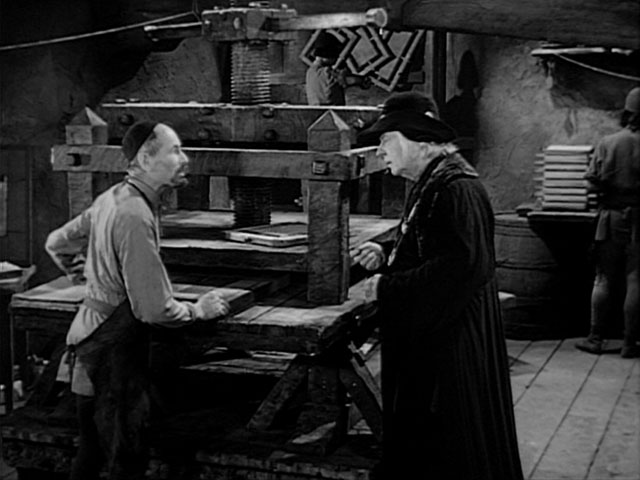
2. Paris printing press
The man tells the king that the German inventor Gutenberg calls it a "printing press."
The king then looks at the Cathedral of Notre Dame.

3. Notre Dame Cathedral
Also in the room is Jean Frollo, a church official.
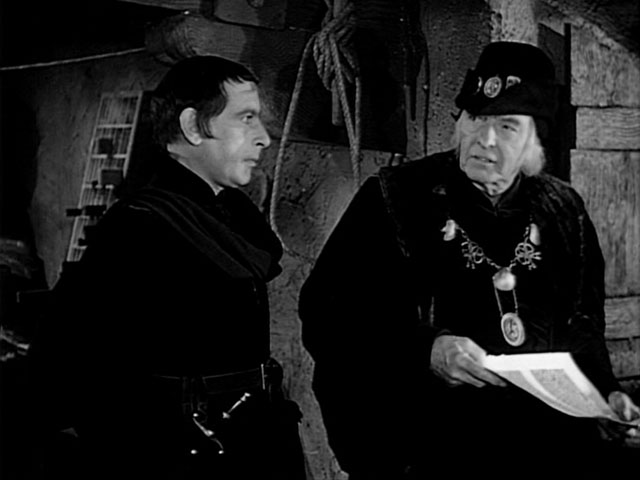
4. Frollo and the king
Jean Frollo, a conservative church official, opposes such devices as the printing press as they
would put too much information in the hands of the people.
The king has more modern beliefs.
The cathedrals are the handwriting of the past.
The press is of our time and I won't do anything to stop it, Frollo.
At the gates of the city, an official stops a group of Gypsies from entering.
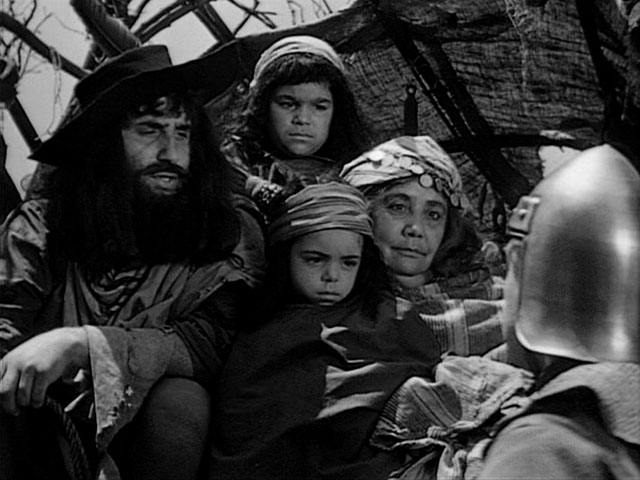
5. Gypsies
One Gypsy woman wears the traditional headdress of coins.
Esmeralda, a beautiful Gypsy dancer, has slipped into the city.
Her goal is to see the king and ask that the ban on her people be lifted.
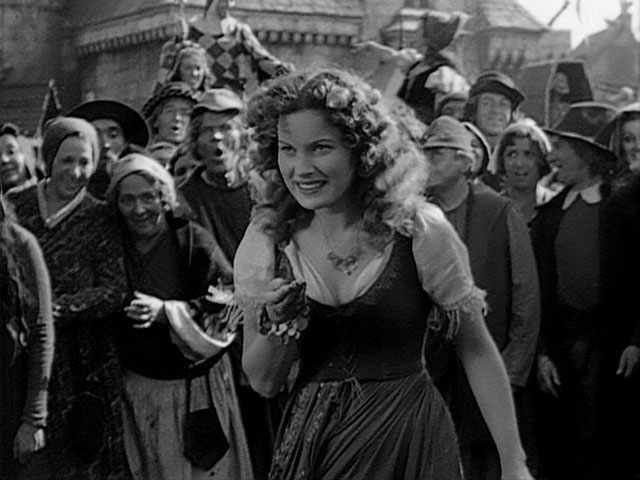
6. Esmeralda
Esmeralda performs her dance routine for the crowd, including the king and Frollo.
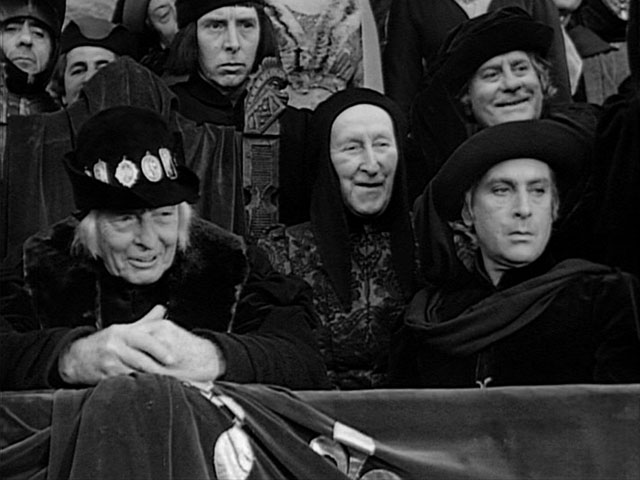
7. The king and Frollo watch
The king wears his cap or hat, a peculiar head covering of his with leaden images of saints
fastened all around the band. Sometimes he would pray to the saints and would add new
images and retire old ones.
The king enjoys Esmeralda's performance and throws her a gold coin, a "half a livre."
Frollo is disgusted with her "lewd" dance but secretly develops a lust for her.
A gold coin of Louis XI:
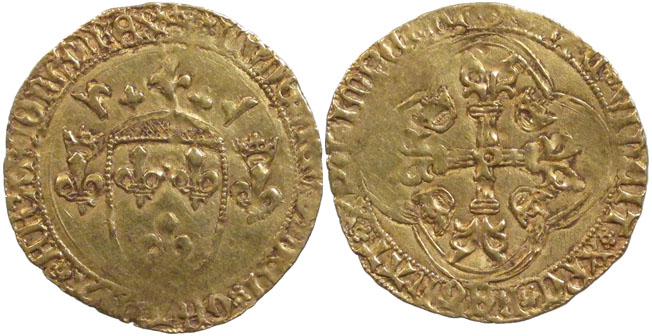
8. France Louis XI Ecu d'Or or crown
Gold, 27 mm, 3.34 gm, Perpignan Mint
Obverse:
Shield with three fleur-de-lis on it and crown above
LVDOVICVS DEI GRA FRANCOR REX
Reverse:
Cross with fleur-de-lis at ends, mintmark 'P' in center (Perpignan Mint)
XPS VINCIT XPS REGNAT XPS IMPERAT (Christ conquers, Christ reigns, Christ commands)
Shield with three fleur-de-lis on it and crown above
LVDOVICVS DEI GRA FRANCOR REX
Cross with fleur-de-lis at ends, mintmark 'P' in center (Perpignan Mint)
XPS VINCIT XPS REGNAT XPS IMPERAT (Christ conquers, Christ reigns, Christ commands)
Back to the film:
At a local fair, the title character appears.

9. The Hunchback of Notre Dame, Quasimodo, appears
Quasimodo is Jean Frollo's adopted son.
Pierre Gringoire, a street poet, also falls for Esmeralda.
Clopin, the "King of the Beggars", finds them and takes them to his underground hideout
where he presides over the city's "underworld."
He gets a cut of money collected by the city's beggars.

10. The King of the Beggars counts his money
For entertainment, Clopin orders Pierre and Esmeralda to marry or die.
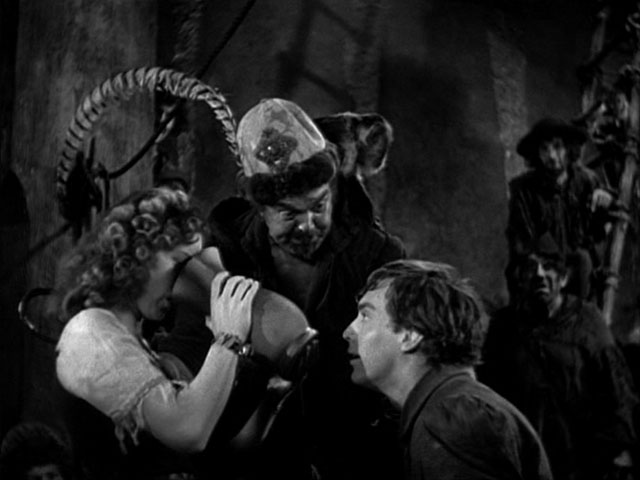
11. The king marries Pierre and Esmeralda
Both realize that the marriage isn't valid but become friends.
Frollo is also thinking about Esmeralda.
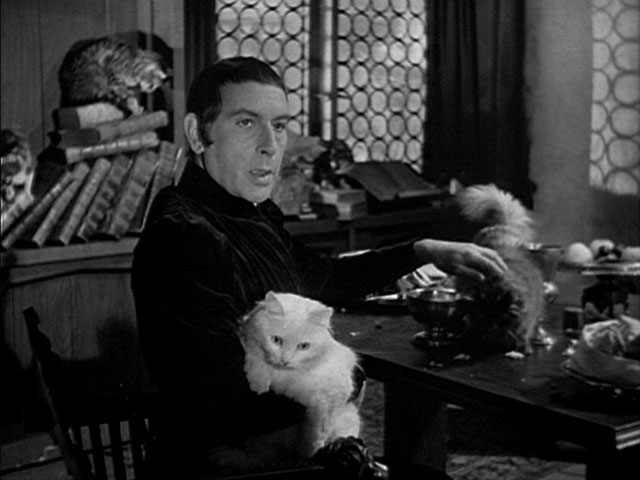
12. Frollo at work
Frollo is not all bad; he likes animals.
A knight makes advances to Esmeralda which she seems to enjoy.
Frollo watches and then kills the knight.
He then has Esmeralda arrested for witchcraft and for killing the knight.
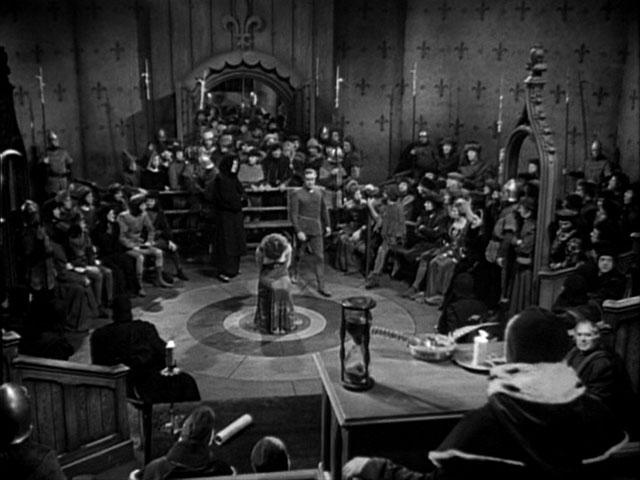
13. Esmeralda on trial
A surprise witness is brought to court to "testify."
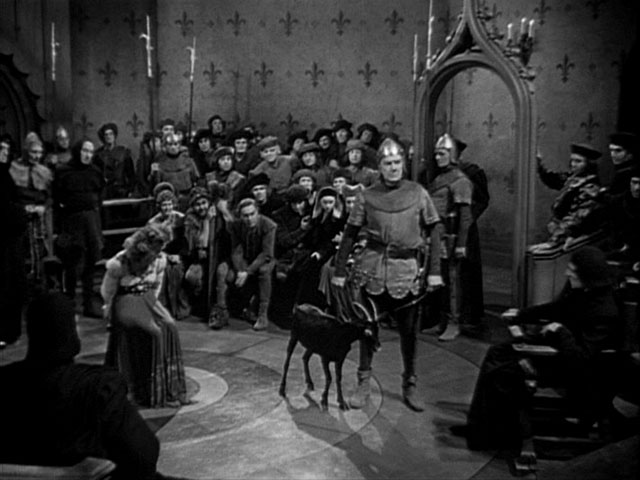
14. The surprise witness
The goat comes to exc and this is interpreted as identifying her as a witch.
The trial has come to the attention of the king who arrives to question the girl.
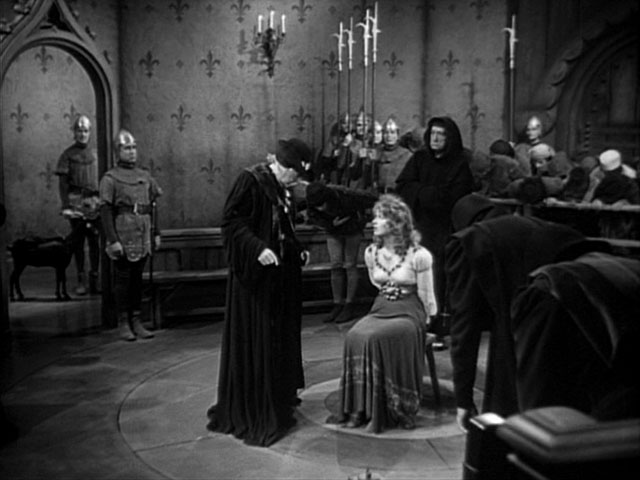
15. Louis questions Esmeralda
He has her blindfolded and asks her to chose one of two knives.
She chooses the wrong one, is convicted, and sentenced to be executed in front of the cathedral.
Esmeralda is taken to the scaffold and a crowd gathers to watch the execution.
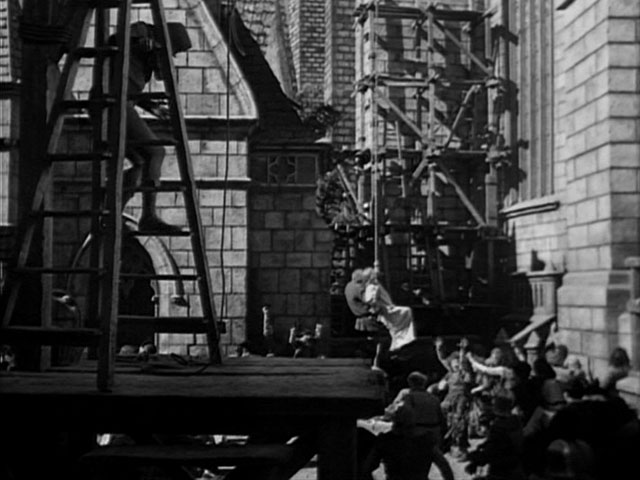
16. Quasimodo swings into action
Quasimodo rescues Esmeralda and takes her up to the church tower where he lives.
Gringoire prints some flyers claiming that Esmeralda is innocent causing a mob to gather
to save the girl.
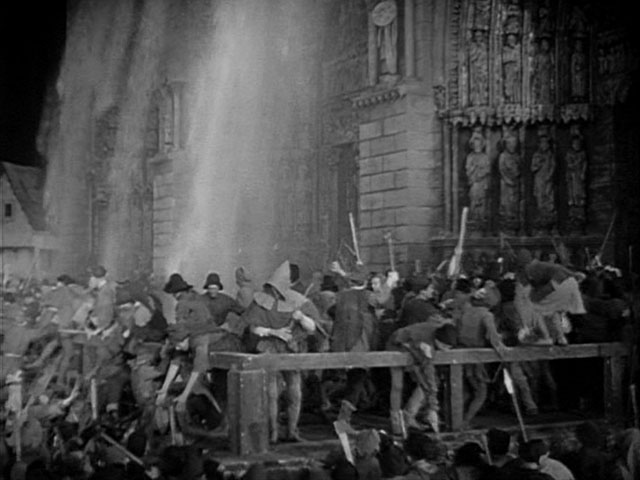
17. The mob attacks the cathedral
Quasimodo drops rocks and hot liquid onto the besiegers and church workers and soldiers
manage to control the crowd.
Frollo arrives and attempts to assault the girl.
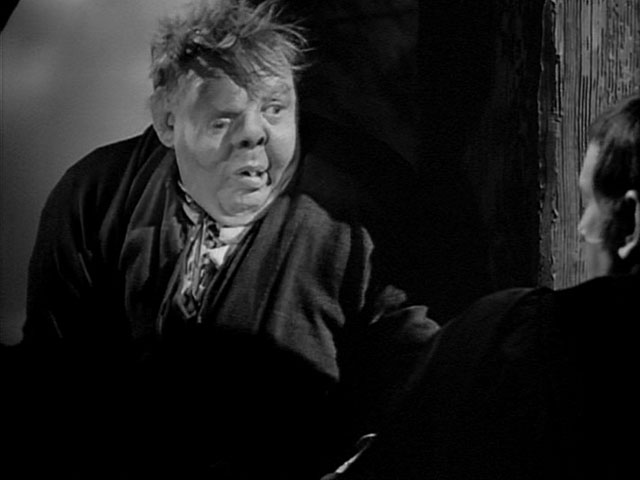
18. Quasimodo confronts Frollo
Quasimodo grabs Frollo and throws him off the tower.
A herald arrives with a message from the king:
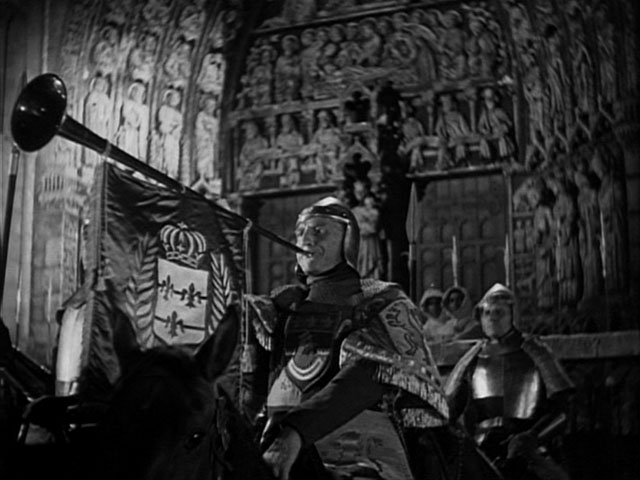
19. Royal announcement
The king has pardoned Esmeralda and will allow her people to enter the city.
Esmeralda and Gringoire of off together leaving Quasimodo back in his tower.

20. Quasimodo and gargoyle
Cast, Directors, Writers:
Maureen O'Hara as Esmeralda
Charles Laughton as Quasimodo
Harry Davenport as King Louis XI
Cedric Hardwicke as Jean Frollo
Thomas Mitchell as Clopin
Edmond O'Brien as Pierre Gringoire
Director: William Dieterle
Writers: Sonya Levien, Bruno Frank, Victor Hugo (novel)
Charles Laughton as Quasimodo
Harry Davenport as King Louis XI
Cedric Hardwicke as Jean Frollo
Thomas Mitchell as Clopin
Edmond O'Brien as Pierre Gringoire
Writers: Sonya Levien, Bruno Frank, Victor Hugo (novel)
| Prev | Back | Next |